Whistling, of all things. Like my fellow “Shenanigan” Alex right next to me, I’m puckering my lips and trying diligently, but the results are modest. Whistling may be a trivial enough task, but not when the atmosphere in our Orlan suits is now down to less than half of the normal sea-level pressure, way too rarefied for any proper sounds to be produced. Even the pitch of our voices is changed as the thinner atmosphere blows on our vocal chords. And the hoarseness in my throat is accompanied by an overall unusual feeling in my airways: not at all unpleasant or disturbing, just very new to me.
In truth, most of today’s exercise hasn’t been much different than several simulations we have run last week at the Cosmonaut Training Center, in Star City. We have put on our blue water-cooling undergarment with its small tubes in which cooled water is circulated to remove heat from our body. We have applied power to the Orlan suit and its computer and we have run the initial configuration checks. Finally we have “entered” the suit, as the Russian friends say. Indeed, you don’t put on the Orlan, you step into it: you connect the communication lines from your headsets, the water pipes from the undergarment, the medical telemetry cables that transmit data about your heart rate, your body temperature, your respiratory frequency; you turn on the fan and the water pump; and then you step into the suit via the “door” in the back and close it behind you by pulling on a steel cable from the front. Simple enough!
Once inside the suit, we have moved on to perform the airlock operations, meaning all the actions that need to be completed prior to removing all air from the airlock and opening the hatch to space. First of all, how about checking that the suit does not leak? To do that, we open the oxygen lines to the suit from the on-board supply and we basically blow the suit up, not much differently than you would an air balloon, and we observe what happens for about a minute. Just like your air balloon is not completely air tight and will eventually deflate, so the Orlan suit does inevitably leak a little bit. We do observe the needle of the differential pressure gauge moving, but as long as the drop is within acceptable limits, the oxygen from the suit bottles will be enough to compensate the losses and keep the suit inflated for many hours.
I must admit that I have paid special attention to the leak check today. After all, when we did this back in Star City nobody was going to make vacuum around us. But here, at the site of the Orlan manufacturer Zvezda, that’s exactly the plan. We are, after all, inside a vacuum chamber.
After the leak check we re-equalize the pressure with the outside and deflate the Orlan. At this point we open again the supply lines to the suit to make sure that we replace all the air inside with pure oxygen. In previous exercises we have simulated this step, but we have never really performed it. Think about it: if the pressure around you will stay at about 1 atmosphere (our normal sea-lever atmospheric pressure), in order to practice working in an inflated suit you need to pressurize it above atmospheric pressure. In fact, about 1,4 atmospheres, or 0,4 atmospheres above the pressure outside. No need to breath pure oxygen in that case: there’s enough oxygen in the normal air. But today we’re going to make vacuum around us, so the pressure inside the suit will eventually be really only 0,4 atmospheres. At this pressure, our normal air does not contain enough oxygen for us to breath, since about 80% of it is actually made of nitrogen: that’s why we need to make sure that we replace all the air with pure oxygen.
Going down to 0,4 atmospheres also presents another problem, one that divers are very familiar with: the risk of decompression sickness. And so, after making sure that no nitrogen is left inside the suit, we need to wait for half an hour to make sure that the nitrogen also diffuses out of our body. No fast forwarding this step today! Now we’re ready: we simulate opening the venting valve to space and the support team turns on the vacuum pump. In a few minutes, it will bring the pressure down to 0.01 mm of mercury: that’s the pressure you would encounter at 65-70 km of altitude. For all practical purposes, it’s vacuum.
As air is progressively pumped out of the chamber, I hear the usual crackles of the suit as it inflates. I feel the space inside the suit grow and the soft internal membranes against my arms and legs rigidize and become hard walls. Everything feels familiar, even as my mind is conscious that the pressure outside is really dropping this time. And then, all of a sudden, the difference becomes obvious: the background sounds from the outside, of which I had not even been aware, become clearly muffled until they completely disappear. We’re acoustically isolated from our surroundings, except from the voice of the support team reaching us via the com cable.
I’m happy about the muffled sounds. I’m happy about the change in the voice pitch and the unusual feeling in my airways. I’m happy about all little signs that remind me about the uniqueness of this experience and I’m grateful to the doctor on console that encourages us to try and whistle. Astronaut training is all about making extraordinary experiences as familiar as possible before we even encounter them. But sometimes I like to take a minute and just enjoy the extraordinary.
Watch the video below, filmed during our training with the Orlan spacesuits:
More photos of the Orlan training (on Flickr)










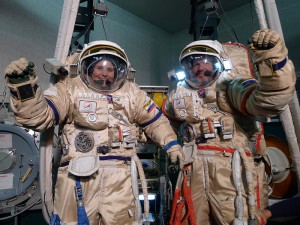
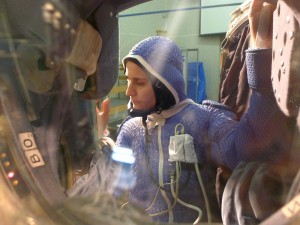
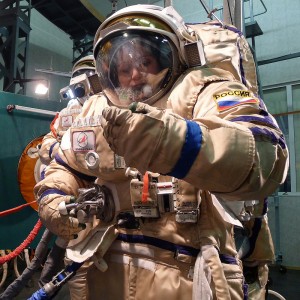
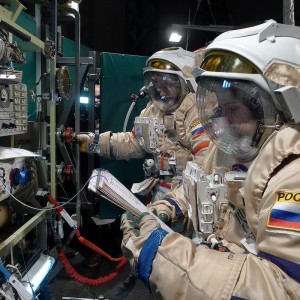
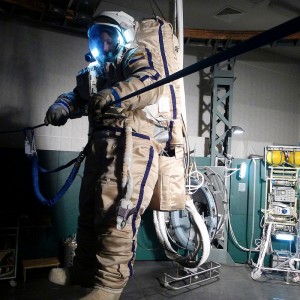
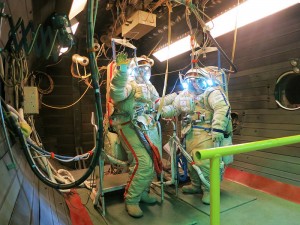
Discussion: 8 comments
As usual I will start with a grazie mille for sharing this with us and I will follow with questions (извините, I always have a lot of questions…): how long does it take to get ready (vs. EMU)? Do you or Alexander have an EVA scheduleв? Can you enter an Orlan (or put on an EMU) without any help?
Merci !!!
Hi Gabrielle! Since the Orlan is one piece, it seems to be easier and quite quicker to get into. I can’t tell you exact times. EVA schedules will be done closer to the flights. You can definitely enter the Orlan without any help. I’m not sure about the EMU, probably not.
Thank you very much!!! It’s good to know that in case of emergency we can jump in an Orlan. Sort of… and if that ever has to happen…
Great article, and surely even better experience!
If I am not mistaken, the Orlan suit has not been redesigned in quite some time, which means it’s flight proven and reliable.
I was wondering if there was any monitoring system on the Orlan suit which would detect depressurization, or any ECLSS malfunctions/failures. If so, how is the wearer notified. Is there an audible alarm or even display?
After trying out that system, what kind of additional features would you like it to have?
Thanks!
Hallo Christopher,
thanks for you interest! The Orlan has an array of sensors that monitor ECLSS parameters. Some of the information only goes to the ground via telemetry, but a lot of data can be monitored by the crewmember at any time.
The standard display of the suit computer will show oxygen tank pressure and battery charge. The same display will show warning messages in case readings are outside of acceptable range. In many cases it will also show suggestions of proper crewmember response. Some situations, like an excessively low pressure in the oxygen tank or a malfunction of the ventilation system will also cause corresponding red LEDs to light up in the helmet area as well as an audible warning tone.
Cara Samantha,
I’m deeply grateful to you for the time you take to share your experiences with us. I’m a med student struggling to get through university and lately the “lows” have been a bit more frequent than the “his”. Reading this though, awakens the sense of wonder and awe for the mechanics of the world we live in that made me choose science over other paths. While I read, your are the heroine of the book I’d need to read and if I try and whistle with you, all the rest gets a bit easier to face.
Grazie di nuovo..e buon lavoro.
Vi
Hello Vi,
thank you very much for your touching feedback.
My best wishes to you for your medicine studies.
Keep whistling and in bocca al lupo!
Samantha
Very interesting Samantha….